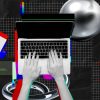Real Estate Link Building That Actually Works: Earn Local Authority, Rankings, and Better Leads Without Spam
Dec 10, 2025

Dec 10, 2025

Dec 10, 2025

Dec 09, 2025

Dec 09, 2025

Dec 05, 2025

Dec 05, 2025

Dec 04, 2025

Dec 04, 2025
Sorry, but nothing matched your search "". Please try again with some different keywords.


Immersive learning mimics childhood experiences where every aspect is experimental and engaging. Technology is recreating this experience using Virtual Reality-VR and Augmented Reality. Such technological developments are having a huge impact on learning by enhancing the classroom environment, helping teachers deliver their lessons, and supporting learning for students.
Virtual Reality and Augmented Reality require heavy investment in gadgets. The quality of the content prepared is enhanced to such detail that the student feels as though he is living in reality. Here is an insightful look into how VR and AR technologies are helping the education sector to achieve its goals easily.
The education sector has been the biggest beneficiary of immersive technologies. Originally, technology was viewed as an intruder because it took away the centrality of the teacher. However, technology has improved learning by allowing students to access learning materials like e-books, buy a PhD thesis online, access citation and editing apps, as well as access other learning materials online.
The education sector brings together teachers, students, administrators, and parents or guardians. The main aim of immersive technology is to improve outcomes for the teacher and students. Parents and administrators on their part can get better returns for their investments. Here are the benefits accruing from immersive technology in the education sector.
The traditional classroom involved a teacher lecturing endlessly on a subject. The understanding of concepts taught in class depended on the imagination of the student. With limited exposure, some of the students would miss the description. They lose interest and in the process earn poor grades.
Immersive learning gives a realistic simulation of situations that the teacher is describing in class. For instance, a VR gadget could simulate the respiratory system from the intake of oxygen to its delivery to the toes of a human being and the exhaling of carbon dioxide. The images are realistic, helping the student to understand the concept better. The same simulation is repeated for chemical procedures, historical events, and physics concepts.
An engaging learning environment helps students to understand the concepts faster and better. The descriptions and explanations will not be lost in their imagination. Consequently, learning becomes more effective and memorable. Students can pursue their passion subjects because they understand the concepts better.
The potential of a student and his passion in a certain area can easily be lost if his learning style is not known. Some students learn by listening to long lectures. Others need to experiment and engage more senses beyond the ears. Some students will miss the concept when one experiment is provided and understand through another. Such accommodations have not been available in the traditional classroom.
VR and AR technology are providing a new dimension to learning. Beyond the description offered by the teacher, a student can alter elements of an experiment to understand the concept better. The reality created by these technologies resembles actual happenings. A student will, therefore, find it easier to relate to the idea displayed in the gadget because of its closeness to reality. The technology increases the percentage of students who understand and follow the class session.
Passion for learning depends on the nature of the learning environment. When physics ideas are simplified in the beginning, the young minds become more curious to explore them in class. Their enthusiasm will not be muted by complex ideas that are delivered as descriptions. As a result, they can pursue advanced courses in some of the traditionally challenging areas like physics, math, chemistry, and biology.
A student struggling with reading books has alternative materials to support learning. Once a student gets details from a book, he can use VR or AR gadgets to deepen his understanding. As a result, he will want to explore the subject further, making learning more interesting.
Students and teachers are looking for the easiest tricks to complete an academic task. Reducing study time enables a student to engage in other activities like games, arts, or personal projects. It also reduces the stress associated with studying.
Virtual Reality presents a more engaging way to study any subject, eliminating the difficulties in understanding. Since a student understands faster, he can cover a larger topic or more concepts in one sitting. It reduces revision time, eliminating stress and burnout associated with academic work.
Every teacher is looking for the best tricks to make his subject understandable. Some use demonstrations and different descriptions to help their students to understand. VR will reduce the descriptions necessary to assist a student to understand a subject. Since the students understand faster, a teacher can cover more areas.
VR and AR technologies make learning different concepts more interesting. As a result, the class will be bubbling with enthusiasm. The teacher does not spend the entire lesson explaining ideas beyond his students’ imagination. It will be easier to attain the desired learning outcomes.
Theoretical learning presents the challenge of description. Some students are not exposed enough to build the imagination required to understand particular concepts. By virtual reality, you eliminate the need for field trips and actual experiments since they can be simulated using gadgets. The simulations are similar to practical work. At the end of a VR session, the student will feel as though he was participating in an actual scenario. Even without practical sessions, the concepts will still be understood.
An engaging learning environment ignites enthusiasm in students. If they can understand the concepts faster and in detail, they will be more curious. They push their knowledge to another level, making them more skilled in the area you are covering. As a result, you produce better outcomes from your teaching session.
Augmented Reality and Virtual Reality are transforming the modern-day classroom. They make the environment more engaging for the student and teacher. Such an engaging environment will also reduce teaching and study time, producing better results for each learning session.
Read Also:
Mashum Mollah is the feature writer of SEM and an SEO Analyst at iDream Agency. Over the last 3 years, He has successfully developed and implemented online marketing, SEO, and conversion campaigns for 50+ businesses of all sizes. He is the co-founder of SMM.
View all Posts
Real Estate Link Building That Actually Works...
Dec 10, 2025
Why Health-Conscious Consumers Choose Blockch...
Dec 10, 2025
How To Buy Xupikobzo987Model? Decoding The Mo...
Dec 09, 2025
Workplace Management EWMagWork: Is This Smar...
Dec 09, 2025
Social Media Stuff EmbedTree: Is This Digita...
Dec 05, 2025

